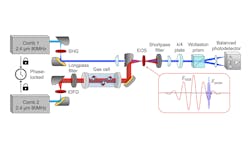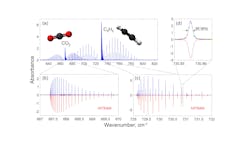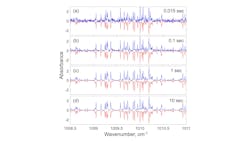Dual-comb spectroscopy measures 240,000 spectral points in longwave infrared at video rate
A perfect spectroscopic system would be able to record most vibrational and rotational molecular transitions within a mixture of gases and accurately correlate every absorption feature to its constituent molecule, and determine the exact composition of the sample. It would enable us to see numerous biomarkers in human breath and revolutionize early medical diagnostics, detect the exact pollution levels in terrestrial atmospheric samples to keep our planet safe, or to search for complex molecules in exoplanet atmospheres and redefine our place within the universe.
A dream system like this is now closer to reality, because researchers at the University of Central Florida’s College of Optics and Photonics (CREOL; Orlando, FL) can now obtain absorption spectra of gaseous molecules over a remarkably broad spectral range of 1.5 to 45 THz (6.6 to 200 µm in wavelength) with up to 240,000 spectral data points in a single measurement spanning as wide as one optical octave or more and in real time (see Fig. 1).1 These spectra contain absorption peaks in a frequency scale calibrated with atomic clock precision and are taken using commonly available near-infrared (NIR) room-temperature photodetectors in a spectral range that typically implies cryogenics and horrendous detector price tags.
Design work
As a driving source, the UCF team uses two mutually coherent chromium-doped zinc sulfide (Cr:ZnS) Kerr-lens-mode-locked laser combs centered at λ≈2.35 μm, which were developed in collaboration with IPG Photonics. The combs have a repetition frequency (frep) of 80 MHz, with a small offset Δfrep ~ 100 Hz between the two combs, which is the essence of the dual-comb spectroscopy method pioneered two decades ago.2
One comb is frequency downconverted via intrapulse difference frequency generation in a nonlinear material (gallium selenide [GaSe] or zinc-germanium diphosphide [ZnGeP2]) to produce an ultrabroadband longwave “sensing” comb, while the second comb is frequency doubled to produce a few-optical-cycle NIR “probe” comb for electro-optic sampling (EOS), a method to detect infrared (IR) transients that enables capturing massive amounts of spectral information—200,000 comb-mode-resolved spectral lines spaced by 80 MHz in the mid-infrared (MIR) portion of the spectrum with instantaneous spectral coverage exceeding an octave at a video rate of 69 Hz. It is also facilitated by the low noise of the dual-comb system with a signal-to-noise ratio limited by the shot noise of the NIR electro-optic sampling (EOS) balanced detection system. Finer resolution (10 MHz), compared to the comb-mode spacing (80 MHz), is obtained by gradually shifting the combs’ repetition frequency and interleaving the obtained spectra.
Results
Thanks to the absolute referencing of the frequency scale, the setup produces spectra that are dead-on with HITRAN database simulations—the worldwide standard for simulating atmospheric molecular transmission and radiance.
The results in Figure 2 for carbon dioxide/acetylene (CO2/C2H2) are obtained by interleaving eight tooth-resolved spectra each measured at a slightly shifted spacing (frep) of the combs with an increment of ~ 10 MHz, taken as a coherent average of 100,000 interferograms, and measured over a period of 18 minutes. The spectra are fantastic matches to HITRAN but in an active environment, i.e. urban or industrial areas, take way too long to measure. This setup isn’t inherently slow—only the averaging is. The lower bound for acquisition time is 1/Δfrep (in this case 1/69 Hz = 0.015 s). Even though a 0.015-s single waveform has significant noise, as shown in Figure 3, comparing it with the HITRAN simulation readily identifies the fine structure lines of methanol with a signal-to-noise ratio of 22.
Accurate identification of molecules without averaging or interleaving means sampling can occur at tens of times per second rather than every 18 minutes.
While the above results are exciting, CO2/C2H2 and methanol spectra aren’t terrifically novel or interesting, so the group turned their attention to ethanol, isoprene, and dimethyl sulfide. These molecules are produced by biological systems, and their spectra are useful for medical breath analysis, terrestrial environmental monitoring, and exobiological research.
Ethanol is a well-known byproduct of anaerobic sugar digestion by yeast. Detection in human breath can signal intentional or unintentional ethanol intoxication; detection in Earth’s atmosphere is an indicator of human ethanol production pollution; and detection in an exoplanet’s atmosphere could be explained by (but not prove) mass sugar production and anaerobic digestion.
Isoprene is regularly produced by trees and is exhaled by humans. Isoprene release in humans is associated with cholesterol production, so its detection could give clues to certain health conditions. Isoprene is also an indicator of vegetation density in the terrestrial atmosphere and can signal the presence of vegetation on exoplanets.
Dimethyl sulfide (CH3)2S) is produced in large quantities on Earth by algae and phytoplankton and is an indicator of their presence. Last year, Madhusudhan et. al. detected dimethyl sulfide in the atmosphere of exoplanet K2-18b3 which, while not proving the existence of life on the planet, is an inspiring result (see Fig. 4).
The group was able to take high-resolution measurements all the way down to 1.5 THz and up to 45 THz (6.7 μm), with the only gap in measurement coming from the Reststrahlen band (residual radiation) of GaSe at approximately 5 to 10 THz. These low frequencies are difficult to record and near impossible at room temperature, but they encompass important rotational transitions of molecules, so being able to measure clean spectra in this range and not needing to deal with any cryogenic system to do it is significant.
These achievements open so many possibilities for medical and environmental innovation. In a future when diagnoses are given from breathing into a bag and our dictionary of exoplanet atmospheric compositions gains a couple volumes, systems like this could very well enable it.
REFERENCES
1. D. Konnov, A. Muraviev, S. Vasilyev, and K. Vodopyanov, APL Photonics, 8, 110801 (2023).
2. F. Keilmann, C. Gohle, and R. Holzwarth, Opt. Lett., 29, 1542–1544 (2004).
3. N. Madhusudhan et al., Astrophys. J. Lett., 956, L13 (2023).
About the Author
Dmitrii Konnov
Dmitrii Konnov is a research scientist at the University of Central Florida’s Center for Research and Education in Optics and Lasers (CREOL), the College of Optics and Photonics (Orlando, FL).
Jacob Silver
Jacob Silver is a photonics and aerospace engineering student at the University of Central Florida’s Center for Research and Education in Optics and Lasers (CREOL), the College of Optics and Photonics (Orlando, FL).
Andrey Muraviev
Andrey Muraviev is a research scientist at the University of Central Florida’s Center for Research and Education in Optics and Lasers (CREOL), the College of Optics and Photonics (Orlando, FL).
Sergey Vasilyev
Laser Scientist, IPG Photonics Southeast Technology Center
Sergey Vasilyev is an expert in laser design, light-matter interactions, and applications of laser-based sources for spectroscopy. He co-authored more than 100 papers on these topics and has both industrial and academic experience. After graduating from Moscow State University, Dr. Vasilyev earned his Ph.D. through the Russian Academy of Sciences. Since 2011, he has been a Laser Scientist with IPG Photonics Southeast Technology Center. He and his colleagues at IPG Photonics Southeast Technology Center hold a number of world records in the field of ultrafast mid-infrared lasers and frequency combs.
Konstantin Vodopyanov
Konstantin Vodopyanov is 21st Century Scholar Chair & Professor of Optics at the University of Central Florida’s Center for Research and Education in Optics and Lasers (CREOL), the College of Optics and Photonics (Orlando, FL).



